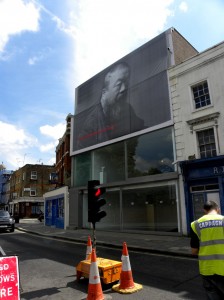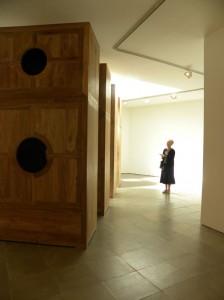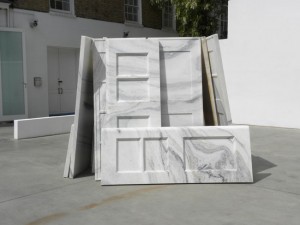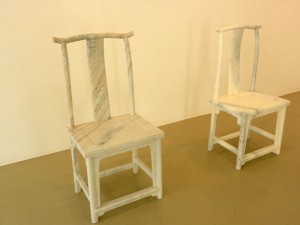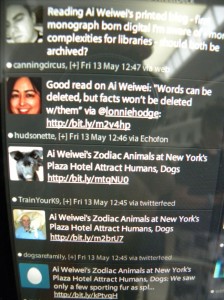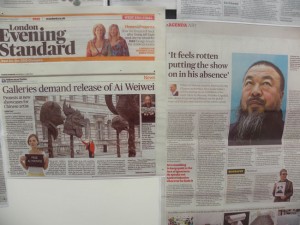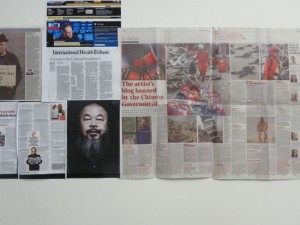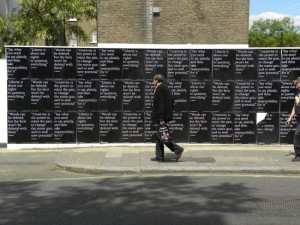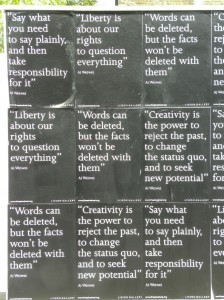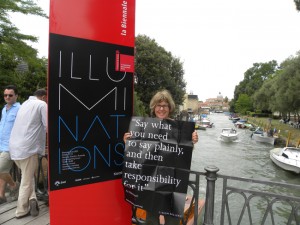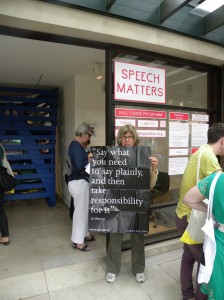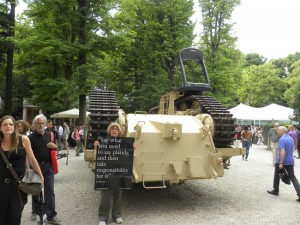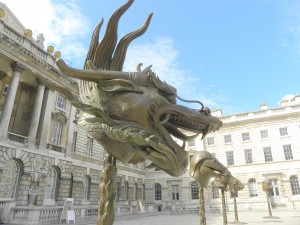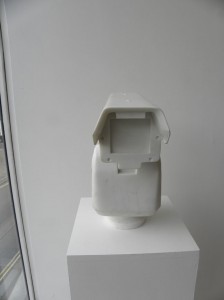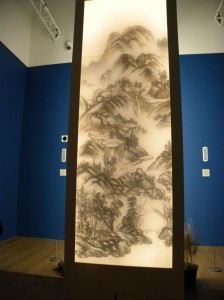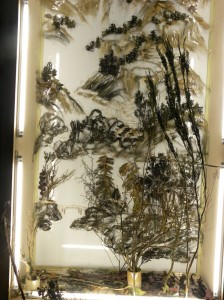Free Ai Weiwei! Exhibitions and Protests
Two exhibitions of Ai Weiwei’s work opened in London May 12 and 13 amidst his continuing detention in China. He had a brief visit with his wife on May 16, perhaps in response to the international outcry about his arrest. We don’t know.
The first exhibition at the Lisson Gallery had several media. First, it consisted of large sculptures in wood and marble, most of them enlarged traditional furniture, like a chair or a moon chest or a door.
A second part of the exhibition were Han dynasty pots that had bright industrial color paints dripped over them.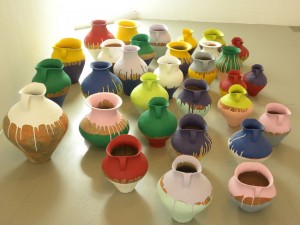
The third part was a pair of videos, one showing a traditional housing area, the other a multilane freeway.
So each of these groups of works created a dialectic between historic China and contemporary life in different ways. The videos were the most straightforward, actually documenting the type of more intimate housing of traditional cities in China, and the impersonal scale and speed of modern urban China. The huge pieces of furniture were useless because they were enlarged to the point of exaggeration, except perhaps the coffin, but it was constructed at an angle that also made it useless.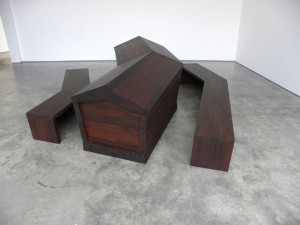
The Han Dynasty pots painted with industrial paint irrevocably altered an ancient pot with contemporary paint, much as China is altering its cultural history and landscape with contemporary development.
But of course it is not Ai Weiwei’s art that is the reason for his detention. It is his command of contemporary media like blogging and twittering.
His blog site was shut down in 2009, although he was twittering with 18 million people(!) right up to the time of his detention. Just before he was taken at an airport, he was tweeting about the arrest of intellectuals and dissidents in China, documenting their arrests. And of course, the Chinese government is really terrified of what has been happening in the Middle East with the people, social media and defiance of the government. The exhibition included some of the tweets as well as other media about his arrest.
Between the two parts of the exhibition was a wall of posters with quotes from Ai Weiwei. They gave out the posters in the exhibition and it is one of these that I took to the Venice Biennale and walked around with it.
Ai Weiwei has a second show in London in the courtyard of Somerset House, which also contains the Courtauld Gallery: a spectacular group of twelve oversized bronze zodiac heads called the Circle of Animals. They are based on an historic garden in China that was designed on the principle of a European garden in the mid 18th century.
The Zodiac heads were designed by an Italian artist as spouts for a water fountain. They were destroyed by Europeans in the nineteenth centur
Ai Weiwei lived in the US 1981 – 1993 when he met Allen Ginsberg in the East Village saw the ready made works of Marcel Duchamp. Much was made of this connection in a discussion at the Somerset House about the artist. He has always been a radical in the Chinese art scene, as a part of the Sun and Stars group in the 1980s, and later. He was friends with Xu Bing in NYC as well ( more about that later). According to Alan Yentob, Creative Director of the BBC, he had an expanded notion of art and thought of himself as a readymade. But his social conscience was always present, which I don’t consider at all Duchampian. Ironic he is not, detached he is not. When he was in the US he photographed homelessness. In China he has criticized the rapid growth and destruction of the land.
For me, the most significant formative source for both Ai Weiwei’s courage and his political outspokenness is his childhood experiences. His father was part of the 100 Flowers Campaign betrayal, when Chinese intellectuals were encouraged to speak up to the government about how things could be improved and then were all sent off into rural detention. His father, a famous poet in China, and his family, were sent to live in the Gobi desert in primitive conditions. Apparently his father was forced to clean toilets.
It seems to me that Ai Weiwei could not stand by and have an easy life making money from his art. He must live his family’s tradition of speaking up to power and paying the price. While other Chinese artists are doing very well and keeping their mouths shut, he is speaking up for what is wrong. Is that Duchampian?? Hardly, but if his life and his social media and his art are all of a piece, there is a continuum that suggests erasing the barrier of art and life. And certainly his marble surveillance camera might be considered an homage to Duchamp’s use of everyday objects. But here there is no use of a real surveillance camera, only a marble one, there is no irony, no humor, only a heavy presence.
The interesting coincidence in London in mid May was that Xu Bing was also having an opening, at the British Museum, and a panel discussion. Xu Bing also spoke of honoring the past, his art work recreated a classical Chinese ink landscape using found materials in London, hemp, grass, some newspaper.
He created a shadow box and the found materials with a light shown through from the back created the simulation of an ink landscape.
But Xu Bing is now vice president of the China Central Academy of Fine Arts in Beijing, he did not answer a question that made reference to Ai Wei Wei. He avoided all reference to politics, although he did say that the Cultural Revolution was disastrous, another period when China was destroying its cultural heritage. He also suggested that his art was a way of regenerating traditional Chinese culture.
There has been a lot more press about Ai Weiwei’s arrest in Europe than in the U.S. And at the opening press conference of the Venice Biennale, Paolo Barrata, President of the Biennale, not known for engaging political issues ( he ignored a strike by workers at the Biennale in 2009), said. “To the Chinese – it would be wonderful to have happy news about Ai Weiwei. The exhibition goes on for six months, we are waiting.”
This entry was posted on May 24, 2011 and is filed under Ai Wei Wei London and Venice, Venice Biennale, Xu Bing London.

